Household products company Church & Dwight (NYSE:CHD) reported results in line with analysts' expectations in Q1 CY2024, with revenue up 5.1% year on year to $1.50 billion. It made a non-GAAP profit of $0.96 per share, improving from its profit of $0.85 per share in the same quarter last year.
Church & Dwight (CHD) Q1 CY2024 Highlights:
- Revenue: $1.50 billion vs analyst estimates of $1.49 billion (small beat)
- EPS (non-GAAP): $0.96 vs analyst estimates of $0.87 (10.1% beat)
- EPS (non-GAAP) Guidance for Q2 CY2024 is $0.83 at the midpoint, below analyst estimates of $0.92
- Full year guidance for organic sales growth maintained (up 4-5% year on year), EPS (non-GAAP) raised slightly (to 8-9% year on year growth)
- Gross Margin (GAAP): 45.7%, up from 43.5% in the same quarter last year
- Free Cash Flow of $216.7 million, up 62.3% from the previous quarter
- Organic Revenue was up 5.2% year on year (beat)
- Sales Volumes were up 3.7% year on year (beat)
- Market Capitalization: $25.92 billion
Best known for its Arm & Hammer baking soda, Church & Dwight (NYSE:CHD) is a household and personal care products company with a vast portfolio that spans laundry detergent to toothbrushes to hair removal creams.
The company traces its history back to 1846, when the brother-in-law founders, John Dwight and Austin Church, started a small business in a New York City tenement. From humble beginnings selling bicarbonate of soda (baking soda), Church & Dwight has grown into a diversified powerhouse with brands such as OxiClean (laundry detergent), Spinbrush (toothbrushes), Nair (hair removal), Trojan (condoms), Vitafusion (vitamins), and many others. As mentioned, Arm & Hammer is highly recognized and versatile, used for baking, cleaning, and deodorizing.
Church & Dwight primarily targets middle-income consumers. These customers are looking for trusted brands since the products will be used on themselves, their family members, and in their own homes. They also want cost-effective products, although many are willing to pay a reasonable premium to buy established brands rather than lesser-known or private-label brands.
It’s not hard to find Church & Dwight’s products in stores. Traditional brick-and-mortar retailers such as supermarkets, mass merchants, drug stores, and specialty stores are the most common sellers of the company’s products. Given Church & Dwight’s scale and traffic-driving brands, the company often has prominent or advantaged placement on retailer shelves.
Household Products
Household products stocks are generally stable investments, as many of the industry's products are essential for a comfortable and functional living space. Recently, there's been a growing emphasis on eco-friendly and sustainable offerings, reflecting the evolving consumer preferences for environmentally conscious options. These trends can be double-edged swords that benefit companies who innovate quickly to take advantage of them and hurt companies that don't invest enough to meet consumers where they want to be with regards to trends.
Competitors that offer a wide range of household and personal care products include Proctor & Gamble (NYSE:PG), Unilever (LSE:ULVR), and Colgate-Palmolive (NYSE:CL).Sales Growth
Church & Dwight is larger than most consumer staples companies and benefits from economies of scale, giving it an edge over its smaller competitors.
As you can see below, the company's annualized revenue growth rate of 6.1% over the last three years was mediocre, but to its credit, consumers bought more of its products.
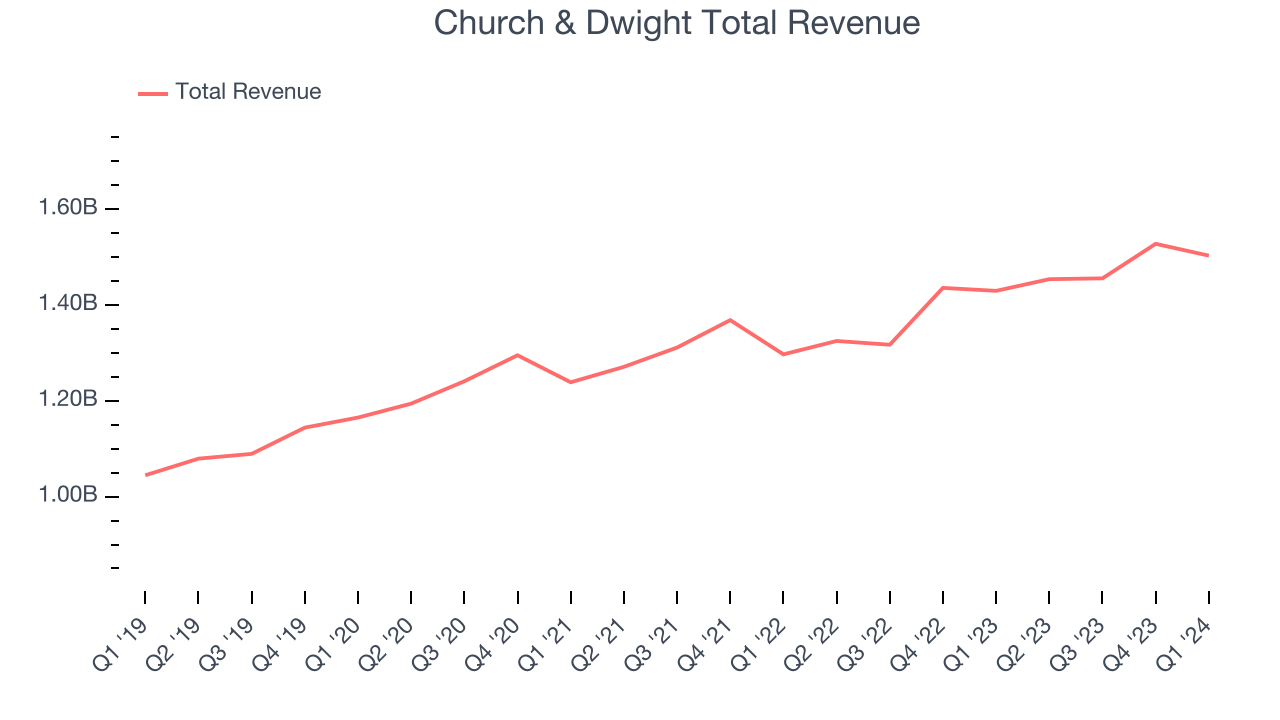
This quarter, Church & Dwight grew its revenue by 5.1% year on year, and its $1.50 billion in revenue was in line with Wall Street's estimates. Looking ahead, Wall Street expects sales to grow 4.1% over the next 12 months, a deceleration from this quarter.
Organic Revenue Growth
When analyzing revenue growth, we care most about organic revenue growth. This metric captures a business's performance excluding the impacts of foreign currency fluctuations and one-time events such as mergers, acquisitions, and divestitures.
The demand for Church & Dwight's products has generally risen over the last two years but lagged behind the broader sector. On average, the company's organic sales have grown by 3.7% year on year.
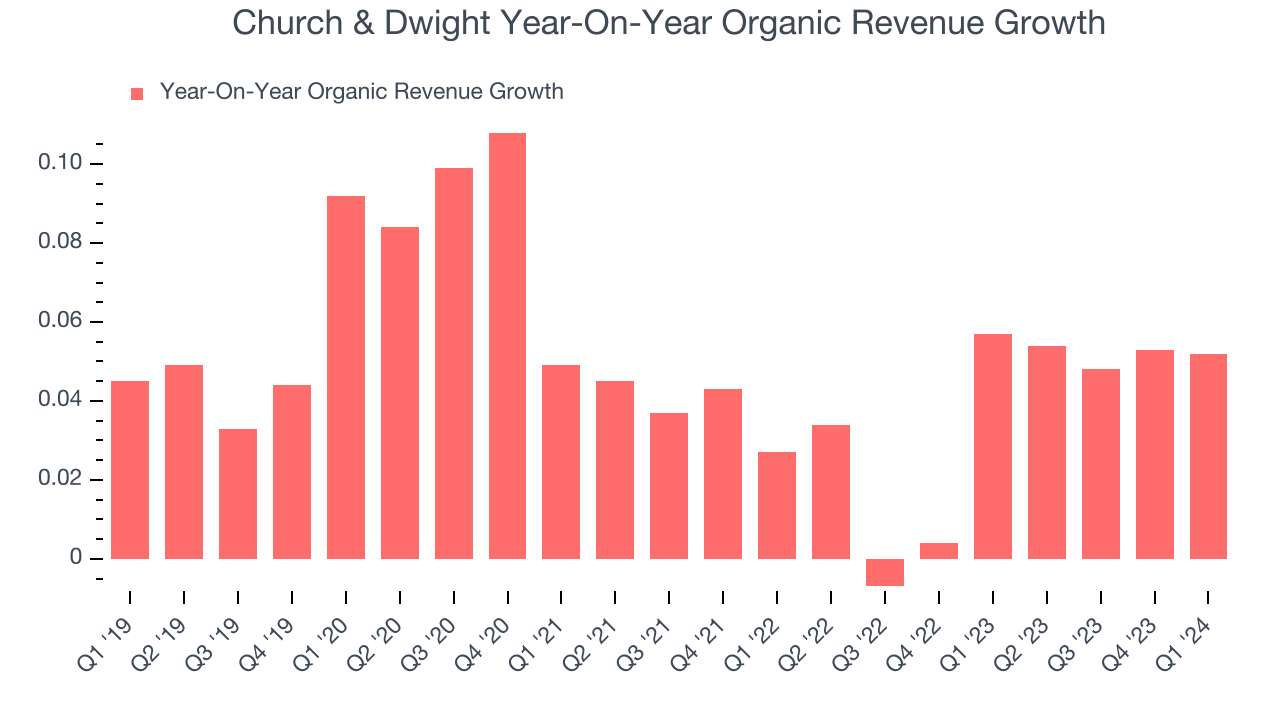
In the latest quarter, Church & Dwight's organic sales rose 5.2% year on year. This growth was in line with the 5.7% year-on-year increase it posted 12 months ago.
Gross Margin & Pricing Power
Gross profit margins tell us how much money a company gets to keep after paying for the direct costs of the goods it sells.
Church & Dwight's gross profit margin came in at 45.7% this quarter, up 2.2 percentage points year on year. That means for every $1 in revenue, $0.54 went towards paying for raw materials, production of goods, and distribution expenses.

Church & Dwight has good unit economics for a consumer staples company, giving it the opportunity to invest in areas such as marketing and talent to stay competitive. As you can see above, it's averaged a healthy 43.4% gross margin over the last two years. Its margin has also been trending up over the last 12 months, averaging 6.1% year-on-year increases each quarter. If this trend continues, it could suggest a less competitive environment where the company has better pricing power and more favorable input costs (such as raw materials).
Operating Margin
Operating margin is a key profitability metric for companies because it accounts for all expenses enabling a business to operate smoothly, including marketing and advertising, IT systems, wages, and other administrative costs.
This quarter, Church & Dwight generated an operating profit margin of 20.3%, in line with the same quarter last year. This indicates the company's costs have been relatively stable.
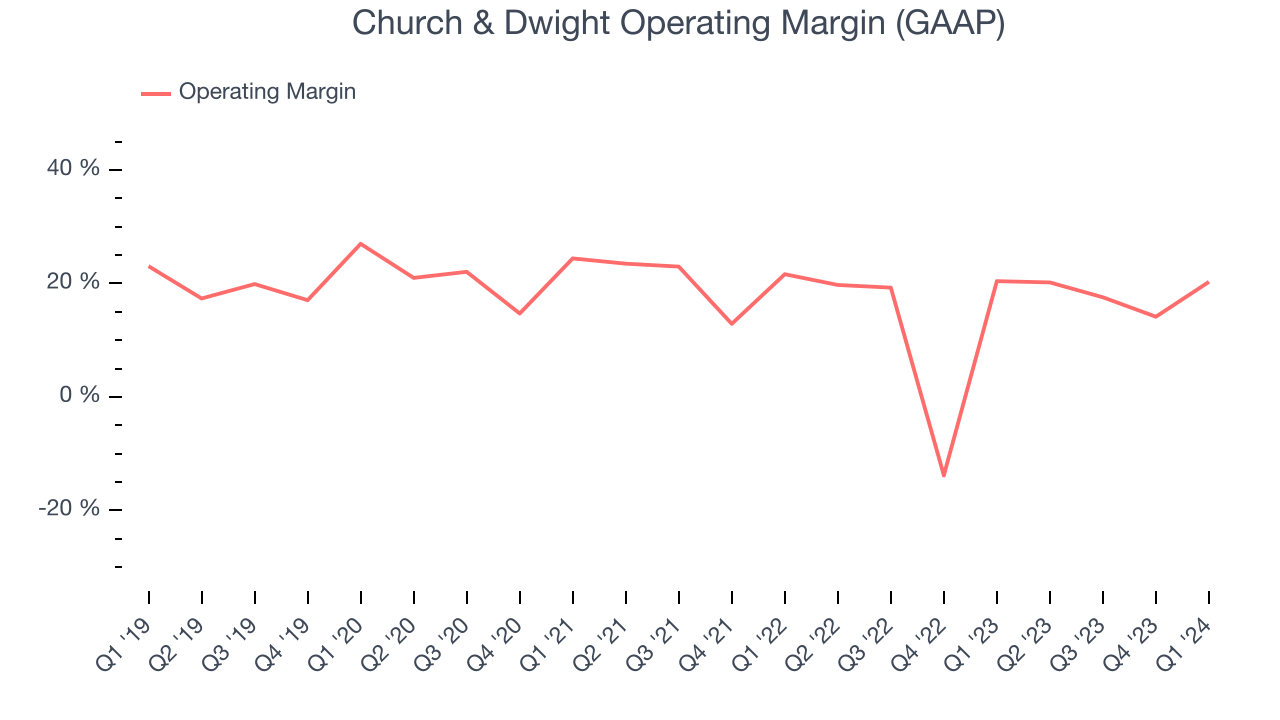 Zooming out, Church & Dwight has managed its expenses well over the last two years. It's demonstrated solid profitability for a consumer staples business, producing an average operating margin of 14.7%. On top of that, its margin has improved by 7 percentage points on average over the last year, a great sign for shareholders.
Zooming out, Church & Dwight has managed its expenses well over the last two years. It's demonstrated solid profitability for a consumer staples business, producing an average operating margin of 14.7%. On top of that, its margin has improved by 7 percentage points on average over the last year, a great sign for shareholders. EPS
Earnings growth is a critical metric to track, but for long-term shareholders, earnings per share (EPS) is more telling because it accounts for dilution and share repurchases.
In Q1, Church & Dwight reported EPS at $0.96, up from $0.85 in the same quarter a year ago. This print beat Wall Street's estimates by 10.1%.
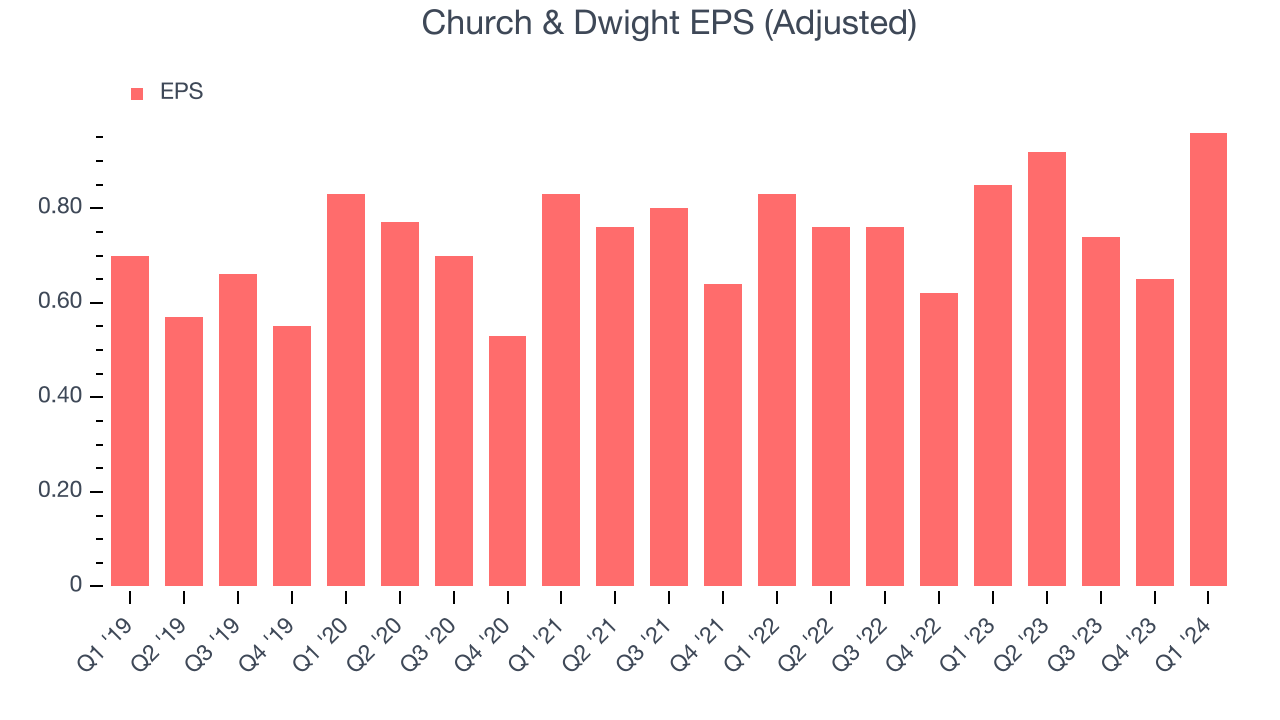
Between FY2021 and FY2024, Church & Dwight's EPS grew 15.5%, translating into an unimpressive 4.9% compounded annual growth rate.
On the bright side, Wall Street expects the company to continue growing earnings over the next 12 months, with analysts projecting an average 7.4% year-on-year increase in EPS.
Cash Is King
Although earnings are undoubtedly valuable for assessing company performance, we believe cash is king because you can't use accounting profits to pay the bills.
Church & Dwight's free cash flow came in at $216.7 million in Q1, down 12.7% year on year. This result represents a 14.4% margin.
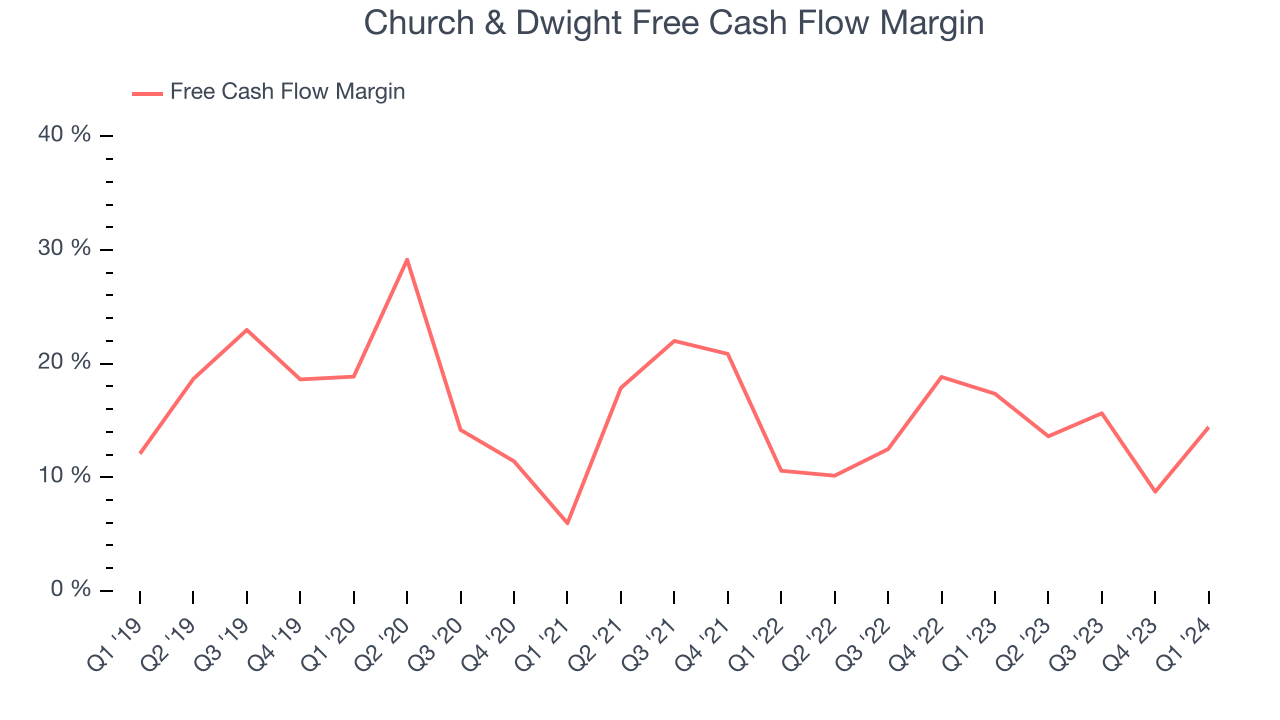
Over the last eight quarters, Church & Dwight has shown terrific cash profitability, enabling it to reinvest, return capital to investors, and stay ahead of the competition while maintaining a robust cash balance. The company's free cash flow margin has been among the best in the consumer staples sector, averaging 13.9%. However, its margin has averaged year-on-year declines of 1.8 percentage points over the last 12 months. If this trend continues, it could signal that the business is becoming slightly more capital-intensive.
Return on Invested Capital (ROIC)
EPS and free cash flow tell us whether a company was profitable while growing revenue. But was it capital-efficient? Enter ROIC, a metric showing how much operating profit a company generates relative to how much money the business raised (debt and equity).
Church & Dwight's five-year average ROIC was 15%, higher than most consumer staples companies. Just as you’d like your investment dollars to generate returns, Church & Dwight's invested capital has produced solid profits.
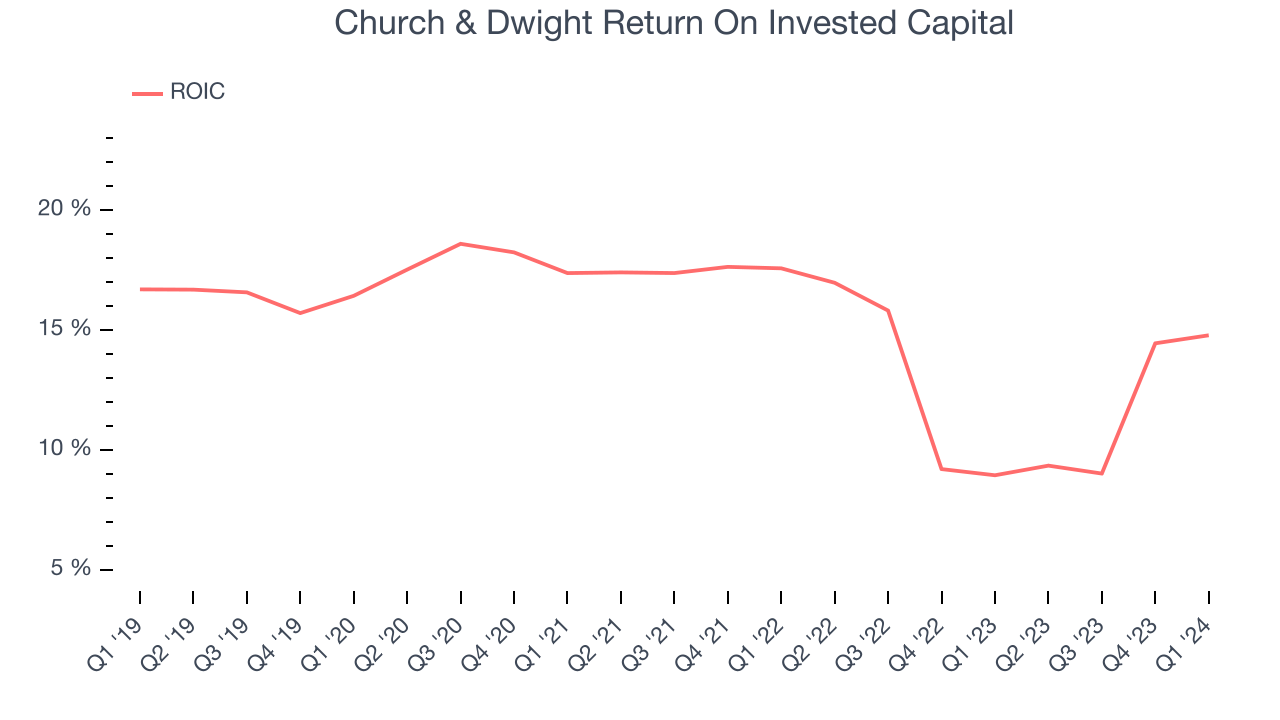
The trend in its ROIC, however, is often what surprises the market and drives the stock price. Unfortunately, Church & Dwight's ROIC averaged 5 percentage point decreases over the last few years. We like what management has done historically but are concerned its ROIC is declining, perhaps a symptom of waning business opportunities to invest profitably.
Balance Sheet Risk
As long-term investors, the risk we care most about is the permanent loss of capital. This can happen when a company goes bankrupt or raises money from a disadvantaged position and is separate from short-term stock price volatility, which we are much less bothered by.
Church & Dwight reported $349.7 million of cash and $2.21 billion of debt on its balance sheet in the most recent quarter. As investors in high-quality companies, we primarily focus on two things: 1) that a company's debt level isn't too high and 2) that its interest payments are not excessively burdening the business.
With $1.32 billion of EBITDA over the last 12 months, we view Church & Dwight's 1.4x net-debt-to-EBITDA ratio as safe. We also see its $82.1 million of annual interest expenses as appropriate. The company's profits give it plenty of breathing room, allowing it to continue investing in new initiatives.
Key Takeaways from Church & Dwight's Q1 Results
We were impressed that Church & Dwight beat analysts' organic revenue growth expectations this quarter. We were also glad its gross margin outperformed Wall Street's estimates. On the other hand, its earnings forecast for next quarter was underwhelming. Looking towards the full year, though, organic sales guidance was maintained and EPS was raised slightly. Overall, this quarter's results were mixed, but we certainly liked the topline performance that exceeded expectations. The stock is flat after reporting and currently trades at $105.95 per share.
Is Now The Time?
Church & Dwight may have had a favorable quarter, but investors should also consider its valuation and business qualities when assessing the investment opportunity.
We have other favorites, but we understand the arguments that Church & Dwight isn't a bad business. Although its revenue growth has been mediocre over the last three years with analysts expecting growth to slow from here, its powerful free cash flow generation enables it to stay ahead of the competition through consistent reinvestment of profits. Investors should still be cautious, however, as its projected EPS for the next year is lacking.
Church & Dwight's price-to-earnings ratio based on the next 12 months is 30.2x. There are things to like about Church & Dwight and there's no doubt it's a bit of a market darling, at least for some investors. But it seems there's a lot of optimism already priced in and we wonder if there are better opportunities elsewhere right now.
Wall Street analysts covering the company had a one-year price target of $103.22 per share right before these results (compared to the current share price of $105.95).
To get the best start with StockStory, check out our most recent stock picks, and then sign up to our earnings alerts by adding companies to your watchlist here. We typically have the quarterly earnings results analyzed within seconds of the data being released, and especially for companies reporting pre-market, this often gives investors the chance to react to the results before the market has fully absorbed the information.
